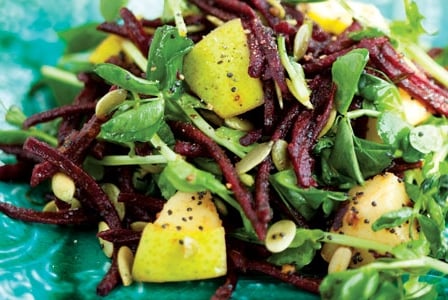
We can fight inflammation and enhance cell regeneration through the foods we eat. These whole food recipes contain nutrients to help reduce inflammation.
We can fight inflammation and enhance cell regeneration through the foods we eat. These whole food recipes contain nutrients to help reduce inflammation.
How well do you regenerate? Your red blood cells are replaced every four months, your skin in 30 days, and the lining of the small intestine renews in less than a week! Each day your body turns over a total of 50 to 70 billion cells.
Through your food choices, you decide if the replacement cells are vibrant or dysfunctional. The quality of the replacement cells relies on the building materials that are available when the new cells are being created. By eating anti-inflammatory foods, newly formed cells can actually be stronger and healthier than the old cells they replace.
What is the major obstacle to cell regeneration?
Inflammation is the body’s response to injury, infection, irritation, or imbalance, causing symptoms of redness, soreness, heat, swelling, or loss of function. We must resolve the infection, remove the irritation, or correct the hormonal imbalance in order to reduce the destruction of cells.
The good news is that by following an anti-inflammatory diet—focusing on phytonutrients in fruit and vegetables and essential fatty acids and amino acids that are plentiful in many things from seeds to seafood—we are able to quench the flames of inflammation and initiate cell repair.
Colour is key
True regeneration occurs when we eat all colours of the food rainbow. Beta carotene, the orange pigment in carrots, squash, and yams, converts to vitamin A, which is important for healing the gastrointestinal tract, lungs, and skin.
Green foods such as asparagus and green beans are rich in vitamin B complex that nourishes the nervous system, increases absorption of omega-3s, and balances our hormones.
Vitamin C-rich foods are often red, as in berries and purple cabbage, and are critical for the production of collagen, the protein that repairs skin, bone, and joints.
Recipes
- Beet Poppy Seed Salad
- Sea Scallops with Harvest Vegetables
- Job’s Tears Whitefish Stew
- Skinny Onion Rings
- Raw-licious Cinnamon Apple Pie
The top 10 picks for inflammation reduction
1. Asparagus
Asparagus boosts levels of glutathione, a powerful antioxidant that ramps up your immune system, warding off invading pathogens that are an underlying cause of inflammation.
2. Seafood
Seafood contains eicosapentaenoic acid, a powerfully anti-inflammatory type of omega-3 fatty acid. A study published in the American Society for Nutrition indicates the oil in fish induces anti-inflammatory gene expression.
3. Pomegranates
Pomegranates have been shown to halt the enzyme reactions the body uses in triggering inflammation and ultimately pain.
4. Mushrooms
Medicinal mushrooms shiitake, maiitake, and cordyceps are very high in polyphenols—nutrients that are effective in protecting liver cells from damage. Supporting the liver is critical in fighting inflammation in the body, as it is where we break down our hormones.
5. Ginger root
Ginger root beats painful inflammation by inhibiting the effects of arachidonic acid, a physiologically necessary fat that is responsible for triggering inflammation and ultimately pain.
6. Seeds
Seeds such as flax, hemp, chia, and perilla are high in alpha-linolenic acid, a type of anti-inflammatory omega-3 fat. Seeds also contain plant sterols, which also have anti-inflammatory properties.
7. Broccoli
Broccoli is rich in sulphoraphane, a chemical that increases the amount of active phase 2 enzymes in the liver, which work to neutralize the harmful toxins we breathe. Further, all cruciferous vegetables are packed with a unique molecule called indole-3-carbinol that reduces inflammatory intermediates in the blood.
8. Berries
Eating berries helps to build one of your body’s most powerful antioxidants: superoxide dismutase (SOD). SOD is important in reducing oxidative stress in our bodies, a key factor in liver support and the prevention of joint pain. Berries are also rich in flavonoids that reduce inflammation and repair cellular damage.
9. Apples
Apples contains calcium D-glucarate, a phytochemical that plays an important role in liver detoxification and estrogen balance by increasing glucuronidation.
10. Herbs
Fresh herbs rosemary, sage, oregano, basil, thyme, and mint contain rosmarinic acid, which has been shown in clinical trials to reduce inflammation.

